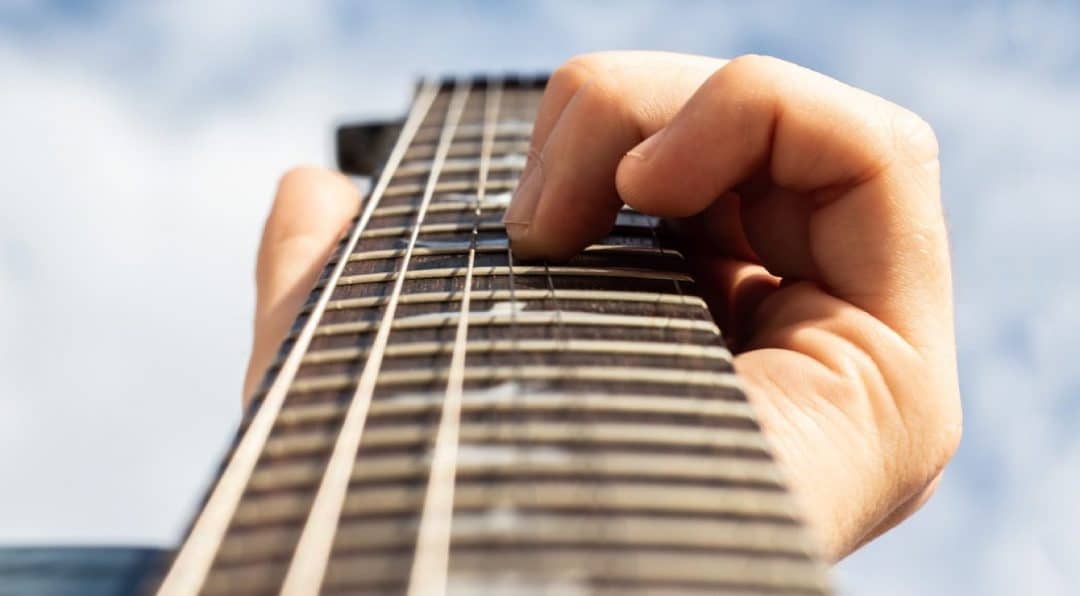Mastering the Guitar Fretboard: A Beginner’s Guide. Learning the guitar fretboard is a crucial step for any aspiring guitarist. It opens up a world of possibilities, allowing you to play with more creativity, confidence, and precision.
Understanding the Basics
Before we jump into the nitty-gritty of fretboard mastery, let’s start with the basics. The guitar fretboard consists of a series of metal frets and strings. The strings are typically labeled from thickest to thinnest as E, A, D, G, B, and high E.

Frets
The frets are the metal bars that run perpendicular to the strings, which you press down to create different notes. The space between two consecutive frets is known as a “half-step.”
Memorizing the Open Notes
To get started, you need to know the open notes of your guitar. These are the notes each string produces when played without any fingers on the frets. Here they are:
- – 6th string (low E) – E
- – 5th string (A) – A
- – 4th string (D) – D
- – 3rd string (G) – G
- – 2nd string (B) – B
- – 1st string (high E) – E
Make sure to commit these notes to memory, as they’ll serve as your reference points as you explore the fretboard.

Understanding the Musical Alphabet
The musical alphabet consists of the following notes: A, B, C, D, E, F, and G. After G, the cycle repeats with A. This cycle continues infinitely in both directions on the fretboard.
Learning the Natural Notes
The natural notes are the white keys on the piano and consist of A, B, C, D, E, F, and G. These notes have no sharp or flat symbols. On the guitar, you can find these natural notes by following the sequence from any open string.

On the fretboard, natural notes repeat in a sequence: C-D-E-F-G-A-B.
Knowing this sequence helps you quickly identify any note on the fretboard. You can start from any note and the sequence will always repeat.
For example, if you start from the open A string, you can find the natural notes as follows:
- – A – Open string – Natural
- – A#/Bb – 1st fret
- – B – 2nd fret – Natural
- – C – 3rd fret – Natural
- – C#/Db – 4th fret
- – D – 5th fret – Natural
- – D#/Eb – 6th fret
- – E – 7th fret – Natural
- – F – 8th fret – Natural
- – F#/Gb – 9th fret
- – G – 10th fret – Natural
- – G#/Ab -11th fret
- – A – 12th fret, which is an octave higher than our starting point – Natural
This sequence repeats on each string, and knowing it is a fundamental step in understanding the fretboard.
Using Octaves and Patterns
Octaves are an essential concept in fretboard mastery. An octave is a musical interval that represents a doubling in pitch.
On the guitar, octaves are found by skipping strings and moving up or down the fretboard.
For example, if you play a note on the 5th fret of the low E string (A), the same note can be found on the 7th fret of the D string.
You can apply this jump/shape to any note on your low E and A strings. When you do, you will find the same note an octave higher on either the D or G strings.
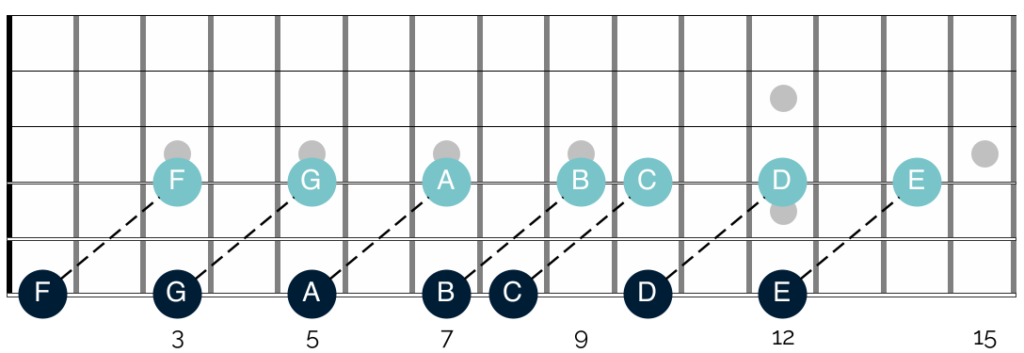
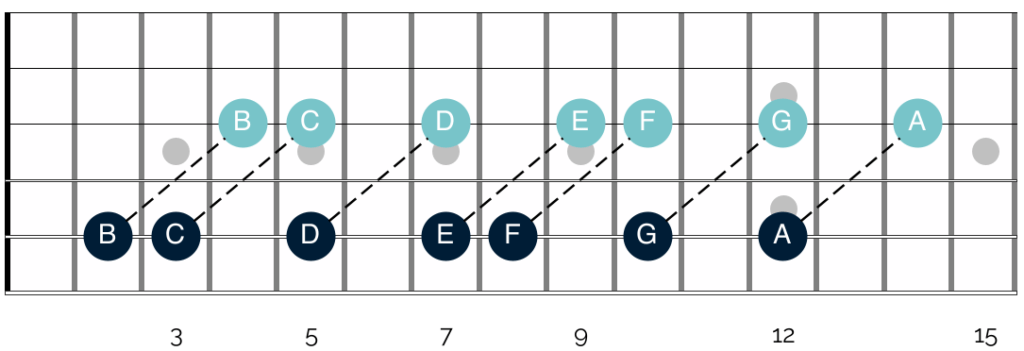
The next useful octave shape to learn is built from notes on the D and G strings. This is a slightly bigger stretch, as you have to move up 2 strings and across 3 frets.
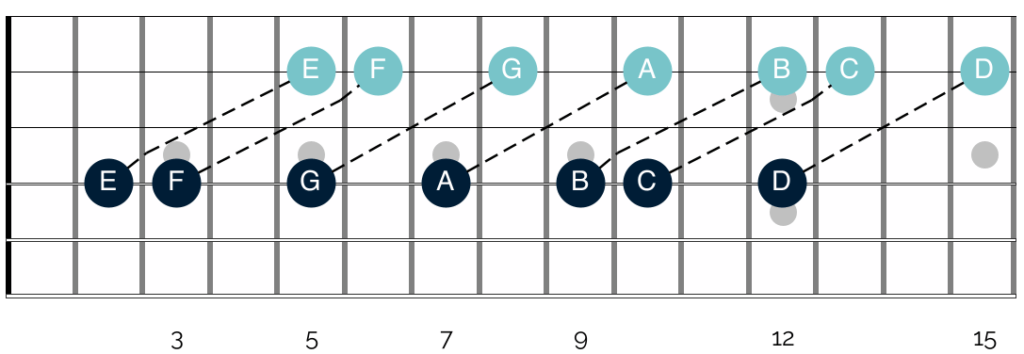
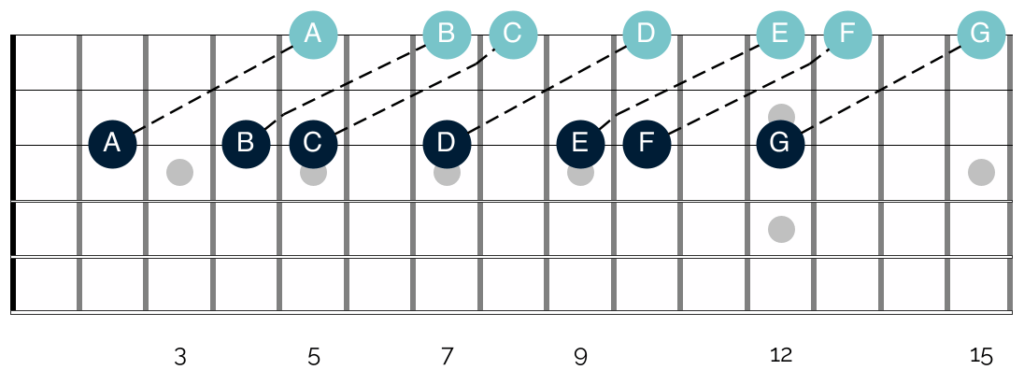
Patterns are another powerful tool for understanding the fretboard. By learning scale patterns and chord shapes, you can unlock the ability to play in various positions on the guitar.
This not only expands your tonal range but also helps you understand the fretboard on a deeper level.
Practice and Patience
Like any skill, mastering the guitar fretboard requires consistent practice and patience. Dedicate time each day to work on your fretboard knowledge. You can practice by playing scales, learning new songs, or simply exploring the fretboard by playing random notes and trying to name them.
Conclusion
Learning the guitar fretboard is a journey, but with dedication and the right approach, you can master it.
Start with the basics, memorize the open notes, understand the musical alphabet and natural notes, use octaves and patterns to your advantage, and, most importantly, practice regularly.
Try to hum or sing the individual notes as you play. This will help train your ear as you are practicing. Making it easier to learn new songs as you begin to master the fretboard.
As you progress, you’ll find that your guitar playing reaches new heights, and you can talk about guitars for hours with the confidence of a true enthusiast.
Remember, the key to success is patience and practice. Happy fretboard mastering!
Video




